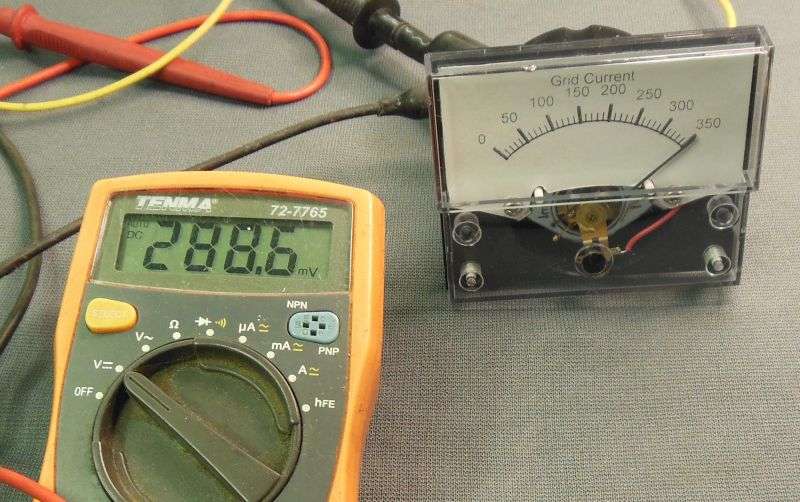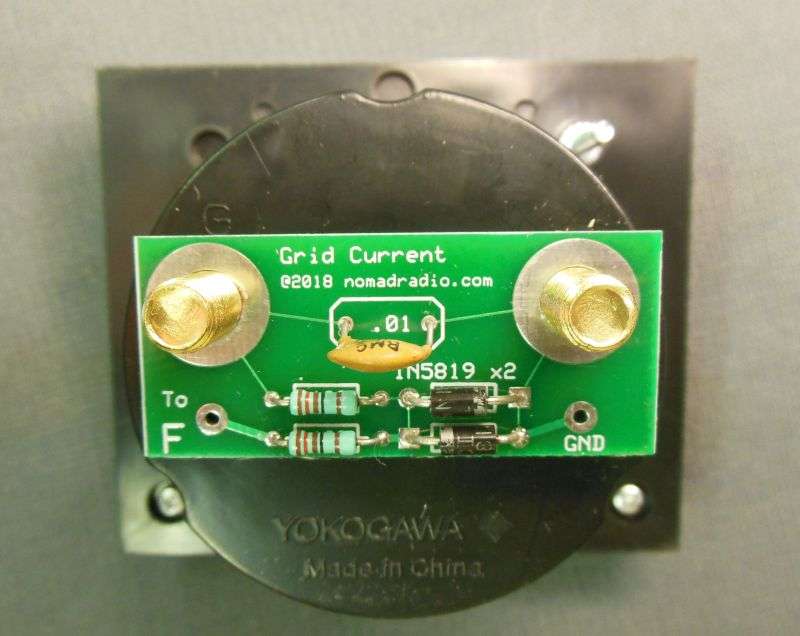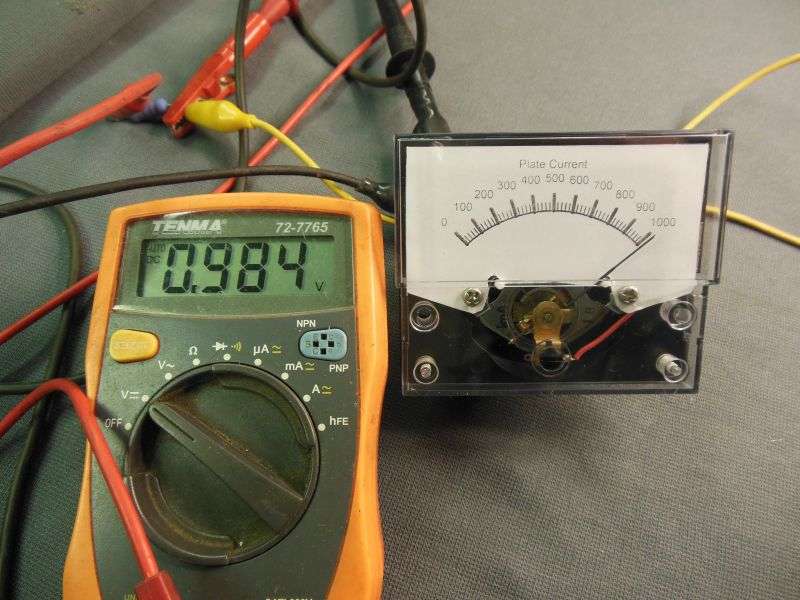This post started as another "Wacky Project" thing. Has to do with using parts you can get to replace parts you can't.
Any more.
Good example is the two analog meters on the front of the Heathkit SB-220, 221, HL2200, etc.
The plate meter on the left has no protection from overload if a tube breaks down, a relay gets dirty, or the coax forgets to get plugged in to the "Ant" socket.
If it goes, it's gone forever unless you can turn over the right rock. They exist as NOS if you have the hundreds of bucks to hold up that rock when you find what you want under it. Fixing a blown meter is like repairing a wristwatch. No point to it, can't get the parts.
The meter on the right has three functions selected by the knob under it. Plate voltage, Relative output and Grid Current.
Again, no protection at all. There's a bonus, though if you keep that selector on "Grid". A tube with a grid-to-cathode short tends to blow out the coil in the meter. There are other, more expensive failures that can also do this, like an arc inside the big (expensive) high-voltage transformer. When (not 'if') the high-voltage secondary winding jumps an arc to the grounded frame of the transformer, it will ALL go through the coil in that meter. And through the 0.82-ohm resistor right behind it. If that one is exploded, the grid meter is almost-certainly toast.
Forever.
Always wasting time looking for a deal on Ebay. I found a batch of partial analog meters. No scale plate inside, no black cover plate snapped over the bottom part of the face.
Most replacement meters packaged in a nice box for individual sale also include nuts and washers to hook it up and mount it to a panel.
These are naked. As you see.
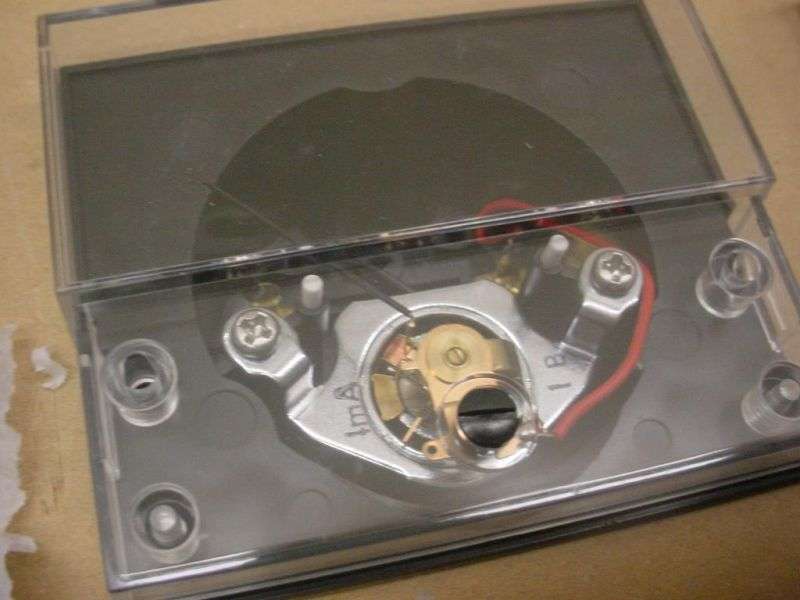
Yes, they're cheap. But the labor to make them presentable as replacement parts is part of the bigger picture.
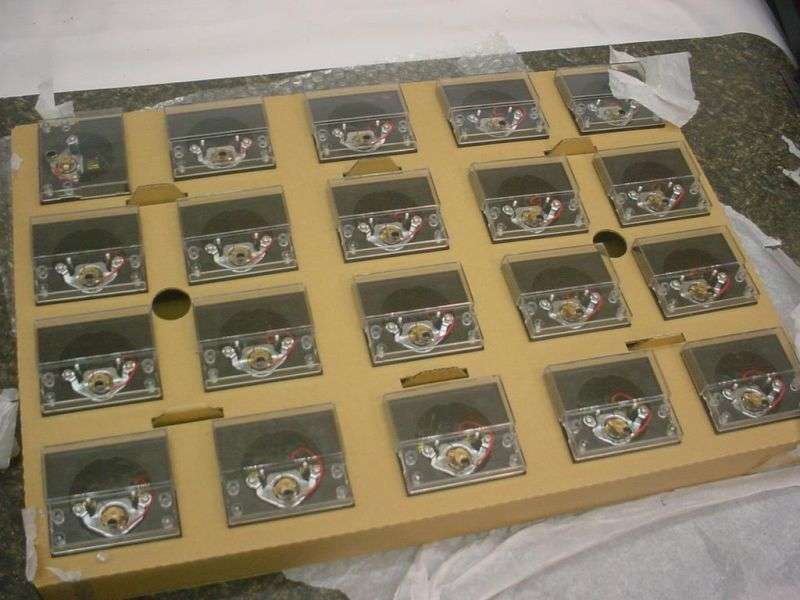
Ebay still shows nine lots of 20 like this one, as of Feb 15.
Let's see if the forum clobbers this URL to that sale https://www.ebay.com/itm/Lot-of-20-New-Yokogawa-255209FAZZ8-UL-MN-2-5HL-1-1mA-DC-1B-Panel-Meters-F022/201553529302?ssPageName=STRK:MEBIDX:IT&_trksid=p2060353.m2749.l2649&autorefresh=true
Feel free to buy as many as you wish. I have tied up all the money I can in this project as it is for now.
I decided to buy a compatible-type meter that HAD a metal scale plate inside. Seemed the most-reasonable way to obtain a template to make my own.
Shopped around, found one for 43 bucks.
And some others that were higher.
Sounds expensive, but lumped in with the rest of this project's expenses, doesn't look like a big penalty.
Haven't cut a plate from 1/32-inch aluminum yet.
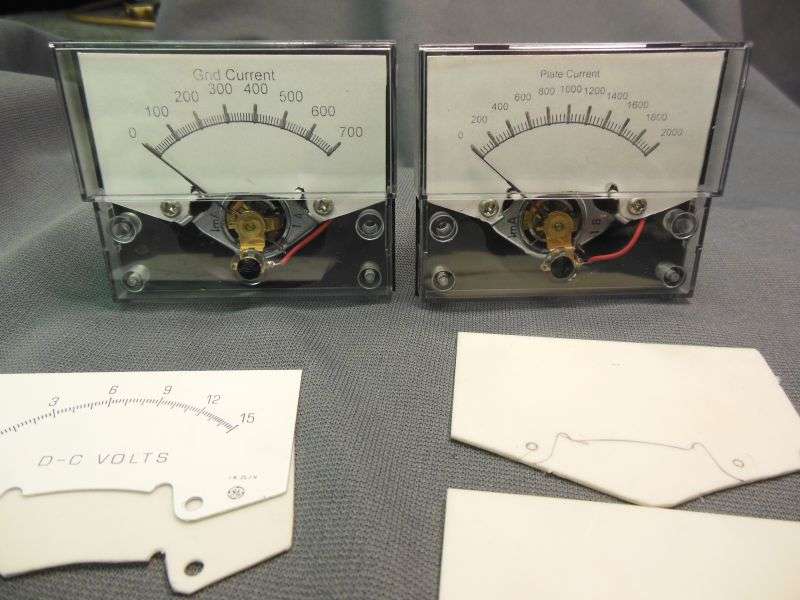
Here is a plate/grid current pair set up for four 3-500Z. The plate is white plastic sheet, with a monochrome laser-printed scale held with double-sided tape.
The "0-15 DC Volts" is what the scale said. Turns out that it's a 1 mA meter coil like the ones I bought a hundred just now. But with a 15k resistor inside it.
The white plastic sheet turns out to be a bit brittle, so it's time to find another material for this.
The 15-Volt meter also had the black plastic "skirt" that wraps around the lower half of the face and snaps in place. Too bad I don't have a 3D plastic printer handy.
Might just use wide black tape for that.
But this post is getting long enough. And I haven't even mentioned that a 1 mA meter with a 17-ohm coil won't just drop in and match the old meters, with 1300 ohms at a 200 uA sensitivity.
Takes only seventeen MILLIVOLTS to push this new meter to the peg.
Takes the original meter around 0.26 Volts DC to push 1 mA through the coil and push the pointer near the peg. That's two hundred and sixty millivolts.
Plenty of leeway here to adapt the new meter. General rule is that if the old meter took a higher voltage on the coil than the new one, all you need to adapt it is resistors.
The right ones.
But what aobut adapting the other way, where a new meter requires more drive voltage than the old one?
Special case. A hostage to how the arithmetic turns out, and how much of the meter-drive circuit you can hack.
But that's what should make these easy to adapt to the Heath SB220. It fits the original opening and mount-stud holes.
The math behind this will just have to wait for now. Tends to put people to sleep, anyhow.
If I can get these to look reasonably legit I'll resell some of them. For now, they will only get used for repairs here.
Maybe not so wacky, this project?
73
Any more.
Good example is the two analog meters on the front of the Heathkit SB-220, 221, HL2200, etc.
The plate meter on the left has no protection from overload if a tube breaks down, a relay gets dirty, or the coax forgets to get plugged in to the "Ant" socket.
If it goes, it's gone forever unless you can turn over the right rock. They exist as NOS if you have the hundreds of bucks to hold up that rock when you find what you want under it. Fixing a blown meter is like repairing a wristwatch. No point to it, can't get the parts.
The meter on the right has three functions selected by the knob under it. Plate voltage, Relative output and Grid Current.
Again, no protection at all. There's a bonus, though if you keep that selector on "Grid". A tube with a grid-to-cathode short tends to blow out the coil in the meter. There are other, more expensive failures that can also do this, like an arc inside the big (expensive) high-voltage transformer. When (not 'if') the high-voltage secondary winding jumps an arc to the grounded frame of the transformer, it will ALL go through the coil in that meter. And through the 0.82-ohm resistor right behind it. If that one is exploded, the grid meter is almost-certainly toast.
Forever.
Always wasting time looking for a deal on Ebay. I found a batch of partial analog meters. No scale plate inside, no black cover plate snapped over the bottom part of the face.
Most replacement meters packaged in a nice box for individual sale also include nuts and washers to hook it up and mount it to a panel.
These are naked. As you see.

Yes, they're cheap. But the labor to make them presentable as replacement parts is part of the bigger picture.

Ebay still shows nine lots of 20 like this one, as of Feb 15.
Let's see if the forum clobbers this URL to that sale https://www.ebay.com/itm/Lot-of-20-New-Yokogawa-255209FAZZ8-UL-MN-2-5HL-1-1mA-DC-1B-Panel-Meters-F022/201553529302?ssPageName=STRK:MEBIDX:IT&_trksid=p2060353.m2749.l2649&autorefresh=true
Feel free to buy as many as you wish. I have tied up all the money I can in this project as it is for now.
I decided to buy a compatible-type meter that HAD a metal scale plate inside. Seemed the most-reasonable way to obtain a template to make my own.
Shopped around, found one for 43 bucks.
And some others that were higher.
Sounds expensive, but lumped in with the rest of this project's expenses, doesn't look like a big penalty.
Haven't cut a plate from 1/32-inch aluminum yet.

Here is a plate/grid current pair set up for four 3-500Z. The plate is white plastic sheet, with a monochrome laser-printed scale held with double-sided tape.
The "0-15 DC Volts" is what the scale said. Turns out that it's a 1 mA meter coil like the ones I bought a hundred just now. But with a 15k resistor inside it.
The white plastic sheet turns out to be a bit brittle, so it's time to find another material for this.
The 15-Volt meter also had the black plastic "skirt" that wraps around the lower half of the face and snaps in place. Too bad I don't have a 3D plastic printer handy.
Might just use wide black tape for that.
But this post is getting long enough. And I haven't even mentioned that a 1 mA meter with a 17-ohm coil won't just drop in and match the old meters, with 1300 ohms at a 200 uA sensitivity.
Takes only seventeen MILLIVOLTS to push this new meter to the peg.
Takes the original meter around 0.26 Volts DC to push 1 mA through the coil and push the pointer near the peg. That's two hundred and sixty millivolts.
Plenty of leeway here to adapt the new meter. General rule is that if the old meter took a higher voltage on the coil than the new one, all you need to adapt it is resistors.
The right ones.
But what aobut adapting the other way, where a new meter requires more drive voltage than the old one?
Special case. A hostage to how the arithmetic turns out, and how much of the meter-drive circuit you can hack.
But that's what should make these easy to adapt to the Heath SB220. It fits the original opening and mount-stud holes.
The math behind this will just have to wait for now. Tends to put people to sleep, anyhow.
If I can get these to look reasonably legit I'll resell some of them. For now, they will only get used for repairs here.
Maybe not so wacky, this project?
73
Last edited:

